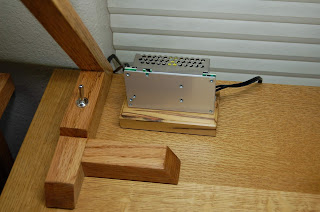LED lights, strip LED lights in particular, for those familiar with this blog, have become vehicles for how I built my own desk lamps. This is my 4th G version as I discovered another manufacturer of LED strip lighting systems. Earlier versions I did a few years back are all still operating even from almost nightly use. Still lighting up my two desks, instantly coming on at the flick of a switch, hardly producing heat, always cool to the touch and operating with the barest amount of electricity are four LED desk lamps.
I chose the new system because of the almost retro look of its low-voltage converter, known as the "driver", which I will explain. Suffice it to say, it has the look of the old vacuum tube amplifiers of the 50's, as you will see. Shown below are two desk lamps built years apart - the one to the right is the latest version. Two others (shown later) are on the other desk.
This is the first project ever, where I actually made an initial full size mock up, from soft cheaper lumber, to see what it would look like because it was difficult to imagine what I had in mind on a piece of drawing paper. Also, as recent projects have been, the piece must use the barest, minimalist amount of material, where no part is without a purpose (none just for aesthetic reasons only).
Manufacturers sell sampler strip lights so customers can see how the lights come out and decide which full length strips to choose for their specific purpose. I purchase the samplers for the purpose of making desk lamps because the 8-inch lengths are about as ideal for desk lamp applications.
 |
Below, the pale looking piece, was the full size mock up - the prototype, if you will.
The next several photos are most of the step by step processes of the actual piece made from white oak. They were put together without using a single piece of hardware. But they must be fastened with glue where the joinery insured maximum structural integrity. Many a project are ruined during the sanding processes or simple handling because of poor joinery.
I actually had to make a jig as extra hands to hold up securely two pieces of wire during soldering. I don't know how I did them in the past but now two extra hands make the task a lot easier.
Heat shrink tubes, also a recent discovery, takes the chore of taping up connections as easy as using a hair dryer or mini torch.
For LED lighting, standard AC power of 110 to 240 volts are converted to anywhere from 5 to 24 volt power sources. Most "drivers, converters, are usually made of closed and compact, directly plugged in devices. This manufacturer, Shoplight Solutions (online contact, Ted Schaefer at ted.schaefer@shoplightsolutions.com) will answer questions via email.
The aluminum material and perforations and screwed in connections make for that retro look of vacuum tube amplifiers I mentioned earlier. To me, it adds to the unique charm of old devices that offered that view of transparency and the good old 50's look. The stained oak and stainless steel toggle switch complete the picture.
The next two photos are of the earlier versions that light up my computer desk in another room.

























No comments:
Post a Comment